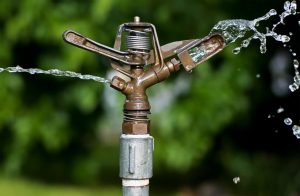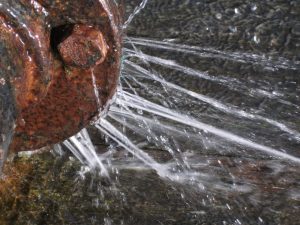 Imagine a day without water. What would you do after you woke up? There would be no shower, no morning cup of coffee, no brushing your teeth, no flushing the toilet. And that’s just first thing in the morning. Imagine the rest of the day without water – it’s almost impossible to do.
Imagine a day without water. What would you do after you woke up? There would be no shower, no morning cup of coffee, no brushing your teeth, no flushing the toilet. And that’s just first thing in the morning. Imagine the rest of the day without water – it’s almost impossible to do.
 Water is life. We’ve heard it before and know it to be true, and yet water is one of the least valued, at least in terms of dollar amounts, resources on the planet. According to the Value of Water Coalition, municipal water in the United States costs the consumer $.01 per gallon, whereas soda costs $2.37 per gallon. In a way, it’s understandable. After all, water isn’t something we think about. If we want fresh, clean water, hot or cold, all we do is turn on the tap. And our wastewater simply flows down the drain or flushes down the toilet. Out of sight, out of mind.
Water is life. We’ve heard it before and know it to be true, and yet water is one of the least valued, at least in terms of dollar amounts, resources on the planet. According to the Value of Water Coalition, municipal water in the United States costs the consumer $.01 per gallon, whereas soda costs $2.37 per gallon. In a way, it’s understandable. After all, water isn’t something we think about. If we want fresh, clean water, hot or cold, all we do is turn on the tap. And our wastewater simply flows down the drain or flushes down the toilet. Out of sight, out of mind.
The reality is that providing safe, clean drinking water and treating our wastewater is in fact a complicated and costly endeavor. There are thousands of pipes running beneath our feet, carrying water from treatment plants where all toxins, bacteria, and other harmful material are removed, and there are even more thousands carrying away our wastewater, ensuring that it is hidden away so we aren’t exposed to it or sickened by it. These pipes run to wastewater treatment plants where the wastewater is treated and cleaned before it is returned to the ground to replenish our water supply.
 One of the greatest achievements of the 20th century was the construction of our nation’s water and sewer systems. Diseases such as typhoid fever and cholera, once prevalent and deadly, were practically eradicated. Industry thrived, the economy flourished, and public health improved exponentially. Our lives and livelihoods depend on water, yet we balk at investing in it. The average monthly cell phone bill is $73, cable TV bill is $99, and internet bill is $47. Yet the average monthly water bill is only about $30. We can all easily imagine a day without our cell phone, cable TV, or internet; these items are luxuries. And yet we pay more for these services than we do for water. That is a sobering fact that needs to change, and soon.
One of the greatest achievements of the 20th century was the construction of our nation’s water and sewer systems. Diseases such as typhoid fever and cholera, once prevalent and deadly, were practically eradicated. Industry thrived, the economy flourished, and public health improved exponentially. Our lives and livelihoods depend on water, yet we balk at investing in it. The average monthly cell phone bill is $73, cable TV bill is $99, and internet bill is $47. Yet the average monthly water bill is only about $30. We can all easily imagine a day without our cell phone, cable TV, or internet; these items are luxuries. And yet we pay more for these services than we do for water. That is a sobering fact that needs to change, and soon.
 According to the Value of Water Coalition, the expected longevity of water and wastewater infrastructure is 50 years, yet the average age of these very pipes in Washington D.C. is 79 years. New England infrastructure is even older, much of it over 100 years old. Aging infrastructure accounts for 1.7 trillion gallons of lost water — water that has already been treated and is clean and ready for drinking — per year, which is the amount of water consumed by the top ten American cities annually. With 43% of our nation experiencing drought, and our demand rising due to population growth, this excessive water loss from failing pipes is crippling. The 1.7 trillion gallons of lost water comes at a staggering cost of $2.6 billion, which is about the amount of money that the federal government allots to water infrastructure annually.
According to the Value of Water Coalition, the expected longevity of water and wastewater infrastructure is 50 years, yet the average age of these very pipes in Washington D.C. is 79 years. New England infrastructure is even older, much of it over 100 years old. Aging infrastructure accounts for 1.7 trillion gallons of lost water — water that has already been treated and is clean and ready for drinking — per year, which is the amount of water consumed by the top ten American cities annually. With 43% of our nation experiencing drought, and our demand rising due to population growth, this excessive water loss from failing pipes is crippling. The 1.7 trillion gallons of lost water comes at a staggering cost of $2.6 billion, which is about the amount of money that the federal government allots to water infrastructure annually.
 To repair our nation’s water and wastewater infrastructure would require an investment of $4.8 trillion over the next 20 years. Yet infrastructure spending is actually down 30% since 2012. Add to that the degradation of our water supply through pollution and environmental damage, and it is clear why communities are struggling to simply meet drinking water standards and to maintain their aging infrastructure, never mind upgrade.
To repair our nation’s water and wastewater infrastructure would require an investment of $4.8 trillion over the next 20 years. Yet infrastructure spending is actually down 30% since 2012. Add to that the degradation of our water supply through pollution and environmental damage, and it is clear why communities are struggling to simply meet drinking water standards and to maintain their aging infrastructure, never mind upgrade.
Hoping to share the value of our world’s most precious resource, the Value of Water Coalition conceptualized “Imagine a Day Without Water.” The inaugural event takes place October 6-8, 2015, and encourages everyone, from water suppliers to engineering firms to concerned citizens, to spread the word about the value of water. It’s easy to see that our transportation infrastructure needs investment; after all, hearing about bridge collapses and failing dams is cause for concern, and the American public demands repairs. But what about water? Again, we don’t see it, so we don’t think about it or talk about it. But if our water system failed, life as we know it would halt. Industry depends on water for manufacturing, agriculture requires irrigation, and we need water simply to go on living.
 The time to invest in our nation’s water and wastewater infrastructure is now. Help spread the word about the value of water, and encourage friends and colleagues to try to imagine a day without water. With some smart investing, careful planning, education, conservation, and governmental support, the most we will need to do is imagine a day without water, not actually live it.
The time to invest in our nation’s water and wastewater infrastructure is now. Help spread the word about the value of water, and encourage friends and colleagues to try to imagine a day without water. With some smart investing, careful planning, education, conservation, and governmental support, the most we will need to do is imagine a day without water, not actually live it.
 Fix a Leak Week is celebrated in the United States each March in order to remind people to check their homes for leaks, both indoors and out. Household leaks account for more than one trillion gallons of wasted water annually in the United States. To put it into perspective, that’s equal to the annual household water use of over 11 million homes. Fix a Leak Week encourages homeowners to repair their dripping faucets, leaky toilets, old showerheads, and faulty irrigation systems in an effort to save our nation’s water. But that’s only part of the problem.
Fix a Leak Week is celebrated in the United States each March in order to remind people to check their homes for leaks, both indoors and out. Household leaks account for more than one trillion gallons of wasted water annually in the United States. To put it into perspective, that’s equal to the annual household water use of over 11 million homes. Fix a Leak Week encourages homeowners to repair their dripping faucets, leaky toilets, old showerheads, and faulty irrigation systems in an effort to save our nation’s water. But that’s only part of the problem.













